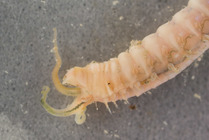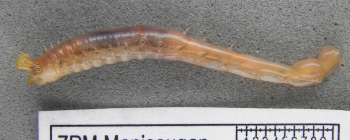WoRMS taxon details
Anobothrus Levinsen, 1884
129158 (urn:lsid:marinespecies.org:taxname:129158)
accepted
Genus
Ampharete gracilis Malmgren, 1866 accepted as Anobothrus gracilis (Malmgren, 1866) (type by monotypy)
Sosanides Hartmann-Schröder, 1965 · unaccepted (subjective synonym)
- Species Anobothrus amourouxi Bonifácio, Lavesque, Bachelet & Parapar, 2015
- Species Anobothrus apaleatus Reuscher, Fiege & Wehe, 2009
- Species Anobothrus auriculatus Alalykina & Polyakova, 2020
- Species Anobothrus bimaculatus Fauchald, 1972
- Species Anobothrus dayi Imajima, Reuscher & Fiege, 2013
- Species Anobothrus debrouweri (Jeldes & Lefevre, 1959)
- Species Anobothrus fimbriatus Imajima, Reuscher & Fiege, 2013
- Species Anobothrus flabelligerulus Imajima, Reuscher & Fiege, 2013
- Species Anobothrus glandularis (Hartmann-Schröder, 1965)
- Species Anobothrus gracilis (Malmgren, 1866)
- Species Anobothrus homus (Chamberlin, 1919)
- Species Anobothrus jirkovi Alalykina & Polyakova, 2020
- Species Anobothrus konstantini Säring & Bick in Säring, Bick & Link, 2022
- Species Anobothrus mancus Fauchald, 1972
- Species Anobothrus mironovi Jirkov, 2009
- Species Anobothrus nataliae Jirkov, 2009
- Species Anobothrus paleaodiscus Schüller & Jirkov, 2013
- Species Anobothrus paleatus Hilbig, 2000
- Species Anobothrus patagonicus (Kinberg, 1866)
- Species Anobothrus patersoni Jirkov, 2009
- Species Anobothrus pseudoampharete Schüller, 2008
- Species Anobothrus rubropaleatus Schüller & Jirkov, 2013
- Species Anobothrus sombrerianus (McIntosh, 1885)
- Species Anobothrus sonne Alalykina & Polyakova, 2020
- Species Anobothrus wakatakamaruae Imajima, 2009
- Species Anobothrus wilhelmi Schüller & Jirkov, 2013
- Species Anobothrus antarctica Monro, 1939 accepted as Anobothrella antarctica (Monro, 1939) (unaccepted > superseded combination, superseded original combination)
- Species Anobothrus laubieri (Desbruyères, 1978) accepted as Melythasides laubieri Desbruyères, 1978 (unaccepted > superseded combination, superseded subsequent combination)
- Species Anobothrus ledanoisi (unaccepted > nomen nudum)
- Species Anobothrus nasuta (Ehlers, 1887) accepted as Amphicteis nasuta Ehlers, 1887 (superseded subsequent combination)
- Species Anobothrus occidentalis Hartman, 1969 accepted as Sosane occidentalis (Hartman, 1969) (superseded original combination)
- Species Anobothrus trilobatus Hartman, 1969 accepted as Eclysippe trilobata (Hartman, 1969) (superseded original combination)
marine, brackish, fresh, terrestrial
recent only
masculine
Levinsen, G.M.R. (1884 (for year 1883)). Systematisk-geografisk Oversigt over de nordiske Annulata, Gephyrea, Chaetognathi og Balanoglossi. <em>Videnskabelige Meddelelser fra den naturhistoriske Forening i Kjöbenhavn.</em> 45(1883): 95-354 + plates II-III., available online at https://biodiversitylibrary.org/page/16065206
page(s): 158, 162 [details]
page(s): 158, 162 [details]
Etymology The derivation of Anobothrus (masculine) was not stated by Levinsen but is a combination of ano- (over, above) or of an-...
Etymology The derivation of Anobothrus (masculine) was not stated by Levinsen but is a combination of ano- (over, above) or of an- (not, without, negative) with the masculine Greek -bothros (trench). How this was intended is not possible to determine. Thus, as Latinized, Anobothrus is masculine. Chávez-López et al (2025) suggest "Anobothrus" may refer to the apparent lack of nephridial papillae to which Levinsen referred in his comparison of Ampharete gracilis with Ampharete [details]
Read, G.; Fauchald, K. (Ed.) (2025). World Polychaeta Database. Anobothrus Levinsen, 1884. Accessed through: World Register of Marine Species at: https://www.marinespecies.org/aphia.php?p=taxdetails&id=129158 on 2025-06-07
Date
action
by
2006-07-31 06:57:06Z
changed
Camba Reu, Cibran
![]() The webpage text is licensed under a Creative Commons
Attribution 4.0 License
The webpage text is licensed under a Creative Commons
Attribution 4.0 License
Nomenclature
original description
Levinsen, G.M.R. (1884 (for year 1883)). Systematisk-geografisk Oversigt over de nordiske Annulata, Gephyrea, Chaetognathi og Balanoglossi. <em>Videnskabelige Meddelelser fra den naturhistoriske Forening i Kjöbenhavn.</em> 45(1883): 95-354 + plates II-III., available online at https://biodiversitylibrary.org/page/16065206
page(s): 158, 162 [details]
original description (of Sosanides Hartmann-Schröder, 1965) Hartmann-Schröder, Gesa. (1965). Zur Kenntnis des Sublitorals der chilenischen Küste unter besonderer Berücksichtigung der Polychaeten und Ostracoden. II Die Polychaeten des Sublitorals. <em>Mitteilungen aus dem Hamburgischen Zoologischen Museum und Institut.</em> 62 Supplement: 59-305.
page(s): 243 [details] Available for editors [request]
[request]
page(s): 158, 162 [details]
original description (of Sosanides Hartmann-Schröder, 1965) Hartmann-Schröder, Gesa. (1965). Zur Kenntnis des Sublitorals der chilenischen Küste unter besonderer Berücksichtigung der Polychaeten und Ostracoden. II Die Polychaeten des Sublitorals. <em>Mitteilungen aus dem Hamburgischen Zoologischen Museum und Institut.</em> 62 Supplement: 59-305.
page(s): 243 [details] Available for editors
Taxonomy
taxonomy source
Chávez-López, Yessica; Alvestad, Tom; Moore, Jenna M. (2025). A review of Anobothrus Levinsen, 1884, restricted, with reinstatement of Anobothrella Hartman, 1967 and Melythasides Desbruyères, 1978, and redescription of seven species (Annelida, Ampharetidae). <em>Zootaxa.</em> 5601(2): 201-245., available online at https://mapress.com/zt/article/view/zootaxa.5601.2.1
note: review [details] Available for editors [request]
[request]
note: review [details] Available for editors
Identification resource
identification resource
Bonifácio, Paulo; Lavesque, Nicolas; Bachelet, Guy; Parapar, Julio. (2015). Anobothrus amourouxi sp. nov., a new species of Ampharetidae (Polychaeta) from the Capbreton Canyon (Bay of Biscay, NE Atlantic Ocean). <em>Journal of the Marine Biological Association of the United Kingdom.</em> 95(5): 961-969., available online at https://doi.org/10.1017/s0025315414002094
note: key to species of Anobothrus [details]
identification resource Alalykina, Inna L.; Polyakova, Neonila E. (2020). New deep-sea species of Anobothrus (Annelida: Ampharetidae) from the Kuril-Kamchatka Trench and adjacent abyssal regions. <em>Progress in Oceanography.</em> 182: 102237., available online at http://www.sciencedirect.com/science/article/pii/S0079661119304173
page(s): 19 of 20; note: Key to the genus [details] Available for editors [request]
[request]
identification resource Säring, Friederike; Bick, Andreas; Link, Heike. (2022). A new species of Anobothrus (Polychaeta, Ampharetidae) from the Weddell Sea (Antarctica), with notes on habitat characteristics and an updated key to the genus. <em>European Journal of Taxonomy.</em> 789(1): 130-152., available online at https://europeanjournaloftaxonomy.eu/index.php/ejt/article/view/1637
page(s): 14 of 23; note: Key to all species of Anobothrus [details] Available for editors [request]
[request]
note: key to species of Anobothrus [details]
identification resource Alalykina, Inna L.; Polyakova, Neonila E. (2020). New deep-sea species of Anobothrus (Annelida: Ampharetidae) from the Kuril-Kamchatka Trench and adjacent abyssal regions. <em>Progress in Oceanography.</em> 182: 102237., available online at http://www.sciencedirect.com/science/article/pii/S0079661119304173
page(s): 19 of 20; note: Key to the genus [details] Available for editors
identification resource Säring, Friederike; Bick, Andreas; Link, Heike. (2022). A new species of Anobothrus (Polychaeta, Ampharetidae) from the Weddell Sea (Antarctica), with notes on habitat characteristics and an updated key to the genus. <em>European Journal of Taxonomy.</em> 789(1): 130-152., available online at https://europeanjournaloftaxonomy.eu/index.php/ejt/article/view/1637
page(s): 14 of 23; note: Key to all species of Anobothrus [details] Available for editors
Other
additional source
Fauchald, K. (1977). The polychaete worms, definitions and keys to the orders, families and genera. <em>Natural History Museum of Los Angeles County: Los Angeles, CA (USA), Science Series.</em> 28:1-188., available online at http://www.vliz.be/imisdocs/publications/123110.pdf [details]
additional source Bellan, G. (2001). Polychaeta, <i>in</i>: Costello, M.J. <i>et al.</i> (Ed.) (2001). European register of marine species: a check-list of the marine species in Europe and a bibliography of guides to their identification. <em>Collection Patrimoines Naturels.</em> 50: 214-231. (look up in IMIS) [details]
additional source Neave, Sheffield Airey. (1939-1996). Nomenclator Zoologicus vol. 1-10 Online. <em>[Online Nomenclator Zoologicus at Checklistbank. Ubio link has gone].</em> , available online at https://www.checklistbank.org/dataset/126539/about [details]
additional source Jirkov, I. A. (2009). Revision of Ampharetidae (Polychaeta) with modified thoracic notopodia. <i>Invertebrate Zoology</i>. 5(2): 111-132 [text date 2008].
page(s): 119; note: Emendation (re-diagnosis of genus) [details]
additional source Bellan, G. (2001). Polychaeta, <i>in</i>: Costello, M.J. <i>et al.</i> (Ed.) (2001). European register of marine species: a check-list of the marine species in Europe and a bibliography of guides to their identification. <em>Collection Patrimoines Naturels.</em> 50: 214-231. (look up in IMIS) [details]
additional source Neave, Sheffield Airey. (1939-1996). Nomenclator Zoologicus vol. 1-10 Online. <em>[Online Nomenclator Zoologicus at Checklistbank. Ubio link has gone].</em> , available online at https://www.checklistbank.org/dataset/126539/about [details]
additional source Jirkov, I. A. (2009). Revision of Ampharetidae (Polychaeta) with modified thoracic notopodia. <i>Invertebrate Zoology</i>. 5(2): 111-132 [text date 2008].
page(s): 119; note: Emendation (re-diagnosis of genus) [details]
 Present
Present  Inaccurate
Inaccurate  Introduced: alien
Introduced: alien  Containing type locality
Containing type locality
From editor or global species database
Diagnosis (after Jirkov, 2009) Prostomium Ampharete-type. One pair of notopodia in posterior thorax (usually TU–8 or TS–5 of the latter) slightly elevated, connected by a low glandular band (sometimes visible only after staining), modified notopodial chaetae sometimes only slightly differ from notopodial chaetae. Connecting band ciliated at least in the type species (Holthe, 1986a). Three or four pairs of branchiae, three pairs form transversal rows without any median gap, the forth (branchiae of S–6), if present, located behind the innermost and connected to them; the inner four branchiae more or less distinctly shorter than outer ones. Circular band in anterior thorax, anterior to notopodia of TU–3 or more rarely TU–2 or TU–1 (?). A pair of large nephridial papillae situated behind branchiae. Neuropodiae of first two AU of thoracic type, followed by normal abdominal ones. [details]Diagnosis (Diagnosis as modified by Chávez-López et al. 2025). Ampharetins with 17 thoracic segments: 15–16 chaetigers, 12 thoracic uncinigers from segment VI (TC4–5). Prostomium Ampharete-type. Segment II with paleae. Segment III with very small, inconspicuous chaetae or without chaetae. Segments IV–XVII with capillary notochaetae. Four pairs of smooth branchiae. Three branchial pairs arranged in transverse row without interbranchial gap, fourth pair immediately behind them. All branchial bases fused forming a high membrane. One or two dorsal nephridial papillae immediately behind innermost pair of branchiae; if two, closely spaced. Buccal tentacles smooth. Circular band on anterior thoracic unciniger 3 (TC6–7). Dorsal ridge on posterior thoracic uncinigers 8–9 (TC11–12). Thoracic uncini with 2 rows of teeth in frontal view. [details]
Etymology The derivation of Anobothrus (masculine) was not stated by Levinsen but is a combination of ano- (over, above) or of an- (not, without, negative) with the masculine Greek -bothros (trench). How this was intended is not possible to determine. Thus, as Latinized, Anobothrus is masculine. Chávez-López et al (2025) suggest "Anobothrus" may refer to the apparent lack of nephridial papillae to which Levinsen referred in his comparison of Ampharete gracilis with Ampharete [details]
Grammatical gender Masculine. Bothrus as Latinized is masculine. Almost all the adjectival species names are masculine to match. Only Anobothrus antarctica Monro, 1939 (currently placed in Anobothrella) is incorrectly gender adjusted. [details]


